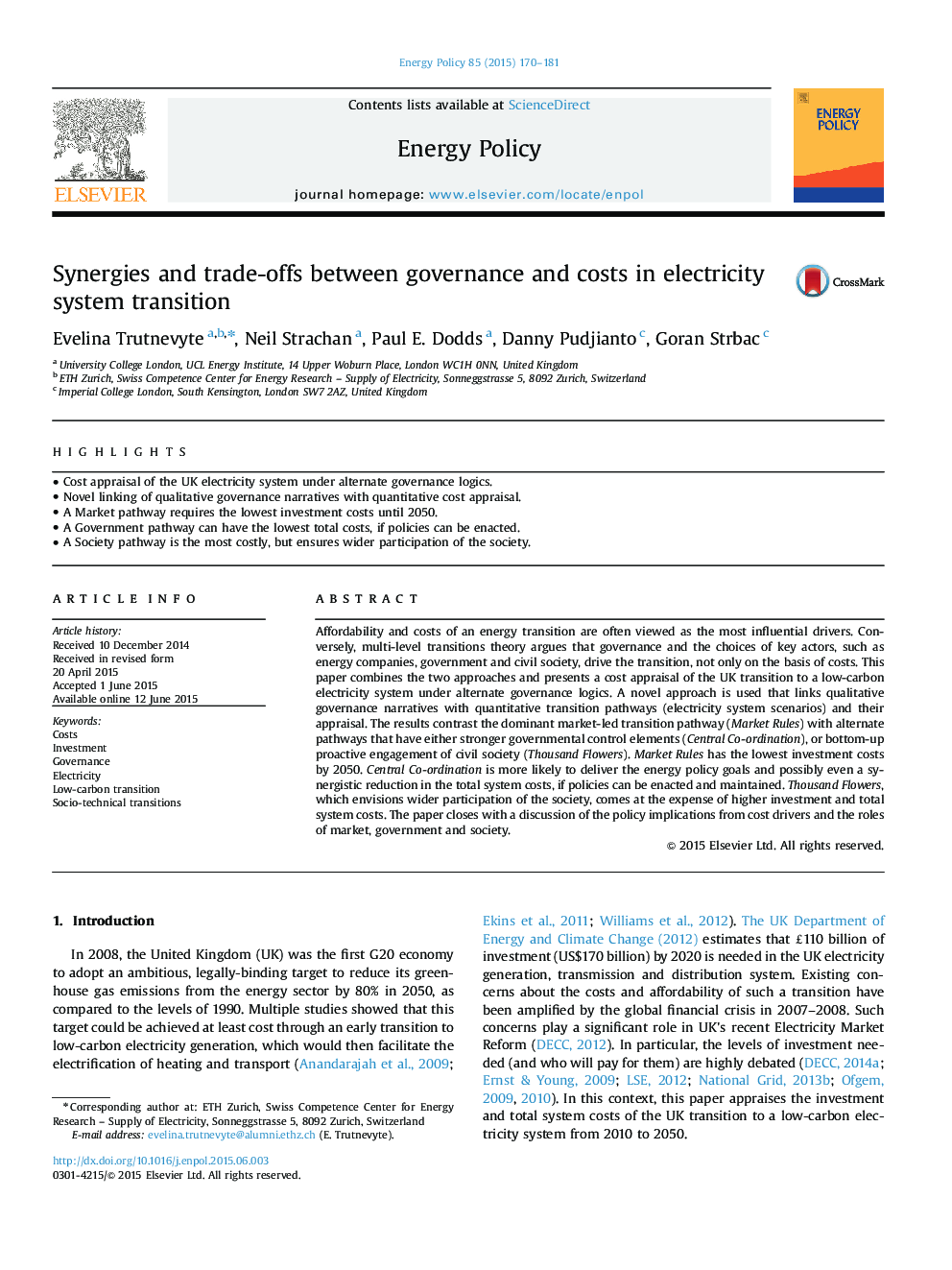| کد مقاله | کد نشریه | سال انتشار | مقاله انگلیسی | نسخه تمام متن |
|---|---|---|---|---|
| 7400823 | 1481273 | 2015 | 12 صفحه PDF | دانلود رایگان |
عنوان انگلیسی مقاله ISI
Synergies and trade-offs between governance and costs in electricity system transition
ترجمه فارسی عنوان
همکاری و همبستگی بین اداره و هزینه های انتقال برق
دانلود مقاله + سفارش ترجمه
دانلود مقاله ISI انگلیسی
رایگان برای ایرانیان
کلمات کلیدی
هزینه ها، سرمایه گذاری، حکومت، برق، انتقال کم کربن، انتقال اجتماعی و فنی،
ترجمه چکیده
مقرون به صرفه بودن و هزینه های انتقال انرژی اغلب به عنوان موثر ترین رانندگان در نظر گرفته می شود. برعکس، تئوری انتقال چند سطح استدلال می کند که حکومت و انتخاب عوامل اصلی، مانند شرکت های انرژی، دولت و جامعه مدنی، نه تنها بر مبنای هزینه ها، انتقال را انجام می دهند. این مقاله این دو رویکرد را ترکیبی می کند و ارزیابی هزینه گذار بریتانیا را به یک سیستم الکتریکی کم کربن تحت منطق های اداری جایگزین ارائه می دهد. رویکرد جدید استفاده شده است که روابط حکومتداری کیفی را با مسیرهای انتقال کمی (سناریو سیستم برق) و ارزیابی آنها پیوند می دهد. نتایج به دست می آید مسیر گذار غالب بازار (قوانین بازار) با مسیرهای متناوب که دارای عناصر کنترل قوی تر (هماهنگی مرکزی) یا مشارکت فعالانه جامعه مدنی از بالا به پایین (هزار گل) است، متضاد است. قوانین بازار کمترین هزینه های سرمایه گذاری را تا سال 2050 به ارمغان می آورد. هماهنگی مرکزی احتمال بیشتری برای تحقق اهداف سیاست انرژی و احتمالا حتی کاهش هم افزایی در کل هزینه های سیستم را فراهم می آورد، اگر سیاست ها بتوانند به اجرا درآید و حفظ شوند. هزار گل، که مشارکت گسترده جامعه را پیش بینی می کند، به هزینه سرمایه گذاری بالاتر و کل هزینه های سیستم می پردازد. این مقاله با بحث درباره مفاهیم سیاست از رانندگان هزینه و نقش بازار، دولت و جامعه بسته می شود.
موضوعات مرتبط
مهندسی و علوم پایه
مهندسی انرژی
مهندسی انرژی و فناوری های برق
چکیده انگلیسی
Affordability and costs of an energy transition are often viewed as the most influential drivers. Conversely, multi-level transitions theory argues that governance and the choices of key actors, such as energy companies, government and civil society, drive the transition, not only on the basis of costs. This paper combines the two approaches and presents a cost appraisal of the UK transition to a low-carbon electricity system under alternate governance logics. A novel approach is used that links qualitative governance narratives with quantitative transition pathways (electricity system scenarios) and their appraisal. The results contrast the dominant market-led transition pathway (Market Rules) with alternate pathways that have either stronger governmental control elements (Central Co-ordination), or bottom-up proactive engagement of civil society (Thousand Flowers). Market Rules has the lowest investment costs by 2050. Central Co-ordination is more likely to deliver the energy policy goals and possibly even a synergistic reduction in the total system costs, if policies can be enacted and maintained. Thousand Flowers, which envisions wider participation of the society, comes at the expense of higher investment and total system costs. The paper closes with a discussion of the policy implications from cost drivers and the roles of market, government and society.
ناشر
Database: Elsevier - ScienceDirect (ساینس دایرکت)
Journal: Energy Policy - Volume 85, October 2015, Pages 170-181
Journal: Energy Policy - Volume 85, October 2015, Pages 170-181
نویسندگان
Evelina Trutnevyte, Neil Strachan, Paul E. Dodds, Danny Pudjianto, Goran Strbac,
